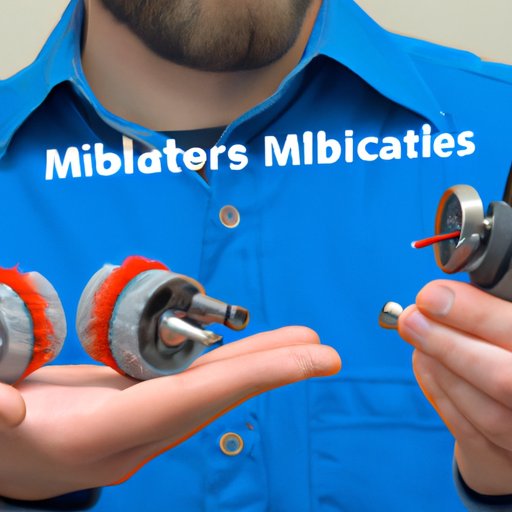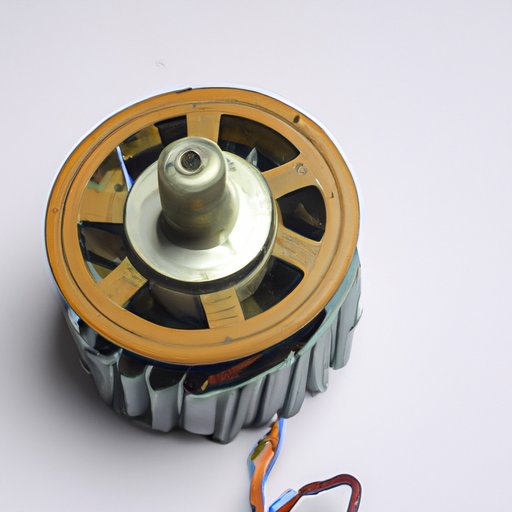Introduction
A brushless motor is an electrical device that converts electrical energy into mechanical energy without the use of brushes. This type of motor is becoming increasingly popular due to its improved efficiency and durability compared to traditional brushed motors. In this article, we will explore how a brushless motor works, the components it is composed of, and the advantages it offers over brushed motors.
Explaining the Basics of Brushless Motors and How They Work
At its most basic level, a brushless motor consists of a stator and a rotor. The stator is a stationary part of the motor and is composed of coils of wire wound around iron laminations. The rotor is comprised of permanent magnets and rotates within the stator. When an electric current is applied to the coils, it creates a magnetic field which interacts with the magnetic field of the rotor, causing it to rotate.
The main difference between a brushed and brushless motor is that a brushed motor uses physical brushes to transfer electricity to the rotor while a brushless motor does not. Instead, brushless motors rely on electronic commutation, which is the process of controlling the direction of current flow in the motor’s windings. This allows the motor to be controlled more precisely than a brushed motor, resulting in improved efficiency and performance.

Examining the Components of a Brushless Motor
A brushless motor consists of several components, including the stator, rotor, magnets, and windings. The stator is a stationary part of the motor and is composed of coils of wire wound around iron laminations. The rotor is composed of permanent magnets and rotates within the stator. When an electric current is applied to the coils, it creates a magnetic field which interacts with the magnetic field of the rotor, causing it to rotate.
The magnets used in brushless motors are typically made from rare earth metals such as neodymium and samarium cobalt. These materials have a very high magnetic strength, allowing them to generate strong magnetic fields. The windings are typically copper or aluminum wires that are wound around the stator to create the electromagnetic field needed for the motor to operate.
Another important component of a brushless motor is the Hall Effect sensor. This sensor is used to detect the position of the rotor and control the speed and direction of the motor. We will now take a closer look at how the Hall Effect sensor works.

Understanding the Role of the Hall Effect Sensor in Brushless Motors
The Hall Effect sensor is used to detect the position of the rotor and control the speed and direction of the motor. The sensor works by detecting changes in the magnetic field generated by the rotor. As the rotor rotates, the sensor sends signals to the motor controller which tells the motor when to start and stop and what direction to rotate.
There are two main types of Hall Effect sensors used in brushless motors: analog and digital. Analog sensors measure the intensity of the magnetic field, while digital sensors measure the frequency of the magnetic field. Digital sensors are more accurate and reliable than analog sensors, but they are also more expensive.

Describing the Advantages of Brushless Motors over Brushed Motors
Brushless motors offer several advantages over brushed motors, including increased efficiency, durability, and cost savings. Brushless motors are up to 90 percent efficient, meaning that most of the energy that goes into the motor is converted into usable power. This is significantly higher than the 50 to 70 percent efficiency of brushed motors.
In addition, brushless motors are much more durable than brushed motors. Because there are no brushes to wear out, brushless motors can last up to 10 times longer than brushed motors. This makes them an ideal choice for applications where reliability and longevity are important.
Finally, brushless motors offer significant cost savings over brushed motors. This is because brushless motors require less maintenance and replacement parts, which can save money over time.
Highlighting the Different Types of Brushless Motors
There are two main types of brushless motors: DC brushless motors and AC brushless motors. DC brushless motors use direct current (DC) to power the motor, while AC brushless motors use alternating current (AC). Both types of motors have their own advantages and disadvantages, so it is important to consider the application before selecting the best type of motor.
Analyzing the Benefits of Installing a Brushless Motor in Your Home or Business
Installing a brushless motor in your home or business offers several benefits, including energy savings, increased control and precision, and improved safety features. Brushless motors are much more efficient than brushed motors, which means they use less energy and can help reduce your energy bills. Additionally, brushless motors offer greater control and precision, allowing you to customize the speed and torque of the motor to suit your needs.
Finally, brushless motors offer improved safety features compared to brushed motors. This is because brushless motors do not require physical contact between the motor and the power source, which eliminates the risk of electric shock.
Conclusion
In conclusion, brushless motors offer numerous advantages over brushed motors, including increased efficiency, durability, and cost savings. They also provide improved control and precision, as well as improved safety features. When selecting a brushless motor, it is important to consider the application and select the best type of motor for your needs. We hope this article has given you a better understanding of how brushless motors work and the benefits they offer.
(Note: Is this article not meeting your expectations? Do you have knowledge or insights to share? Unlock new opportunities and expand your reach by joining our authors team. Click Registration to join us and share your expertise with our readers.)
